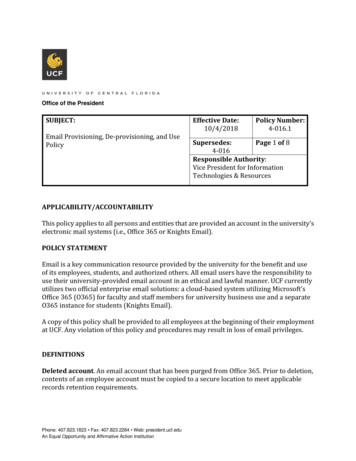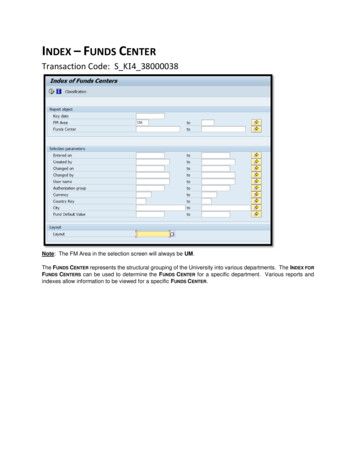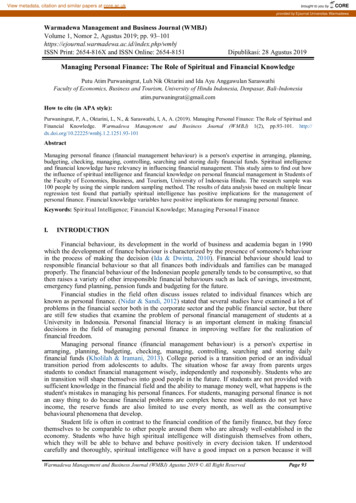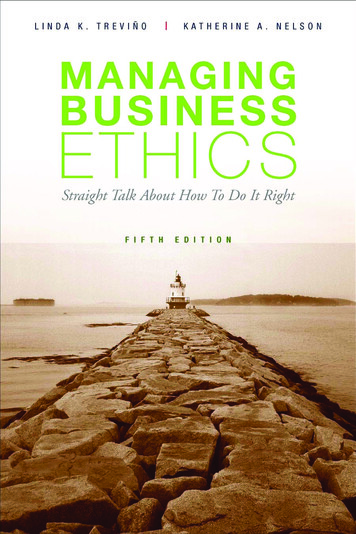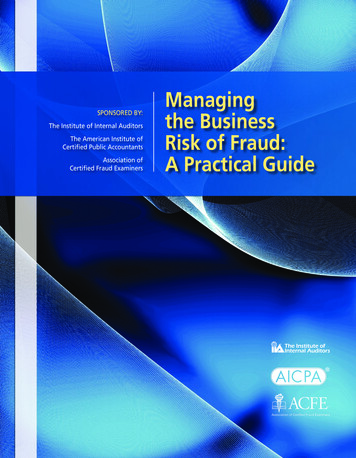
Transcription
Sponsored by:The Institute of Internal AuditorsThe American Institute ofCertified Public AccountantsAssociation ofCertified Fraud ExaminersManagingthe BusinessRisk of Fraud:A Practical Guide1
From the Sponsoring Organizations:The Institute of Internal AuditorsDavid A. Richards, CIA, CPAPresident and Project ManagerThe American Institute of Certified Public AccountantsBarry C. Melancon, CPAPresident and CEOAssociation of Certified Fraud ExaminersJames D. Ratley, CFEPresidentThe views expressed in this document are for guidance purposes only and are not binding on organizations.Organizations should design and implement policies and procedures that best suit them. The IIA, AICPA, and ACFEshall not be responsible for organizations failing to establish policies and procedures that best suit their needs.This guide is intended to be applicable globally but heavily references practices in the United States and, whereavailable, provides references to information from other countries, as well. We anticipate further references will beincluded in future updates.1
Team Members:Toby J.F. Bishop, CPA, CFE, FCADirector, Deloitte Forensic CenterDeloitte Financial Advisory Services LLPJohn D. Gill, JD, CFEResearch DirectorAssociation of Certified Fraud ExaminersCorey Anne Bloom, CA, CA IFA, CFESenior Associate, Dispute Resolution and FinancialInvestigation ServicesRSM Richter Inc.Sandra K. Johnigan, CPA, CFEJohnigan, P.C.Joseph V. Carcello, Ph.D., CIA, CPA, CMADirector of Research, Corporate Governance CenterErnst & Young ProfessorUniversity of TennesseeThomas M. Miller, CPA\ABV, CFE, PITechnical Manager, Forensic and Valuation ServicesAICPALynn Morley, CIA, CGAMorley Consulting & Training Services Inc.David L. Cotton, CPA, CFE, CGFMChairmanCotton & Company LLPThomas SanglierPartnerErnst & Young LLPHolly Daniels, CIA, CISATechnical Director, Standards and GuidanceThe Institute of Internal AuditorsJeffrey SteinhoffManaging Director, Financial Management andAssurance (Retired)U.S. Government Accountability OfficeRonald L. Durkin, CPA, CFE, CIRANational Partner in Charge, Fraud & MisconductInvestigationsKPMG LLPWilliam E. StewartPartner, Fraud Investigation & Dispute ServicesErnst & Young LLPDavid J. Elzinga, CA IFA, CFEPartner, Forensic Accounting & Investigation ServicesGrant Thornton LLPBill WarrenDirector, Fraud Risks and ControlsPricewaterhouseCoopers LLPRobert E. Farrell, CFEPrincipal, White Collar InvestigationsMark F. Zimbelman, Ph.D.Associate Professor and Selvoy J. Boyer FellowBrigham Young UniversityBruce J. Gavioli, CPA, MBAPartner & National Leader, Anti-fraud ConsultingDeloitte Financial Advisory Services LLPProject Advisors:Eleanor BloxhamChief Executive OfficerThe Value Alliance and Corporate Governance AllianceLarry HarringtonVice President, Internal AuditRaytheon Company2
Endorsers:The following organizations endorse the nonbinding guidance of this guide as being of use to management andorganizations interested in making fraud risk management programs work. The views and conclusions expressed inthis guide are those of the authors and have not been adopted, approved, disapproved, or otherwise acted upon bya committee, governing body, or the membership of the endorser.3
Managing the Business Risk of Fraud: A Practical GuideTABLE OF CONTENTSPAGEINTRODUCTION . 5SECTION 1: FRAUD RISK GOVERNANCE . 10SECTION 2: FRAUD RISK ASSESSMENT . 19SECTION 3: FRAUD PREVENTION . 30SECTION 4: FRAUD DETECTION . 34SECTION 5: FRAUD INVESTIGATION AND CORRECTIVE ACTION . 39CONCLUDING COMMENTS . 44APPENDICES:APPENDIX A: REFERENCE MATERIAL . 45APPENDIX B: SAMPLE FRAMEWORK FOR A FRAUD CONTROL POLICY. 48APPENDIX C: SAMPLE FRAUD POLICY . 50APPENDIX D: FRAUD RISK ASSESSMENT FRAMEWORK EXAMPLE . 55APPENDIX E: FRAUD RISK EXPOSURES . 57APPENDIX F: FRAUD PREVENTION SCORECARD . 61APPENDIX G: FRAUD DETECTION SCORECARD . 65APPENDIX H: OCEG FOUNDATION PRINCIPLES THAT RELATE TO FRAUD . 69APPENDIX I: COSO INTERNAL CONTROL INTEGRATED FRAMEWORK . 794
Managing the Business Risk of Fraud: A Practical GuideFraud is any intentional act or omission designed to deceive others, resulting in the victim suffering aloss and/or the perpetrator achieving a gain1.INTRODUCTIONAll organizations are subject to fraud risks. Large frauds have led to the downfall of entire organizations, massiveinvestment losses, significant legal costs, incarceration of key individuals, and erosion of confidence in capitalmarkets. Publicized fraudulent behavior by key executives has negatively impacted the reputations, brands, andimages of many organizations around the globe.Regulations such as the U.S. Foreign Corrupt Practices Act of 1977 (FCPA), the 1997 Organisation for EconomicCo-operation and Development Anti-Bribery Convention, the U.S. Sarbanes-Oxley Act of 2002, the U.S. FederalSentencing Guidelines of 2005, and similar legislation throughout the world have increased management’sresponsibility for fraud risk management.Reactions to recent corporate scandals have led the public and stakeholders to expect organizations to take a“no fraud tolerance” attitude. Good governance principles demand that an organization’s board of directors, orequivalent oversight body, ensure overall high ethical behavior in the organization, regardless of its status as public,private, government, or not-for-profit; its relative size; or its industry. The board’s role is critically important becausehistorically most major frauds are perpetrated by senior management in collusion with other employees2. Vigilanthandling of fraud cases within an organization sends clear signals to the public, stakeholders, and regulators aboutthe board and management’s attitude toward fraud risks and about the organization’s fraud risk tolerance.In addition to the board, personnel at all levels of the organization — including every level of management, staff,and internal auditors, as well as the organization’s external auditors — have responsibility for dealing with fraudrisk. Particularly, they are expected to explain how the organization is responding to heightened regulations, as wellas public and stakeholder scrutiny; what form of fraud risk management program the organization has in place; howit identifies fraud risks; what it is doing to better prevent fraud, or at least detect it sooner; and what process is inplace to investigate fraud and take corrective action3. This guide is designed to help address these tough issues.This guide recommends ways in which boards4, senior management, and internal auditors can fight fraud intheir organization. Specifically, it provides credible guidance from leading professional organizations that definesprinciples and theories for fraud risk management and describes how organizations of various sizes and types canThis definition of fraud was developed uniquely for this guide, and the authors recognize that many other definitions of fraud exist, includingthose developed by the sponsoring organizations and endorsers of this guide.1Refer to The Committee of Sponsoring Organizations of the Treadway Commission’s (COSO’s) 1999 analysis of cases of fraudulent financialstatements investigated by the U.S. Securities and Exchange Commission (SEC).2Refer to June 2007 SEC Commission Guidance Regarding Management’s Report on Internal Control Over Financial Reporting UnderSection 13(a) or 15(d) of the Securities Exchange Act of 1934 and U.S. Public Company Accounting Oversight Board (PCAOB) AuditingStandard No. 5 (AS5), An Audit of Internal Control Over Financial Reporting That Is Integrated With an Audit of Financial Statements, forcomments on fraud responsibilities.3Throughout this paper the terms board and board of directors refer to the governing body of the organization. The terms chief executiveofficer (CEO) and chief financial officer (CFO) refer to the senior level management individuals responsible for overall organizationperformance and financial reporting.45
establish their own fraud risk management program. The guide includes examples of key program components andresources that organizations can use as a starting place to develop a fraud risk management program effectivelyand efficiently. Each organization needs to assess the degree of emphasis to place on fraud risk management basedon its size and circumstances.Executive SummaryAs noted, fraud is any intentional act or omission designed to deceive others, resulting in the victim suffering a lossand/or the perpetrator achieving a gain. Regardless of culture, ethnicity, religion, or other factors, certain individualswill be motivated to commit fraud. A 2007 Oversight Systems study5 discovered that the primary reasons why fraudoccurs are “pressures to do ‘whatever it takes’ to meet goals” (81 percent of respondents) and “to seek personalgain” (72 percent). Additionally, many respondents indicated that “they do not consider their actions fraudulent”(40 percent) as a reason for wrongful behavior.Only through diligent and ongoing effort can an organization protect itself against significant acts of fraud. Keyprinciples for proactively establishing an environment to effectively manage an organization’s fraud risk include:Principle 1: As part of an organization’s governance structure, a fraud risk management program6should be in place, including a written policy (or policies) to convey the expectations of theboard of directors and senior management regarding managing fraud risk.Principle 2: Fraud risk exposure should be assessed periodically by the organization to identify specificpotential schemes and events that the organization needs to mitigate.Principle 3: Prevention techniques to avoid potential key fraud risk events should be established, wherefeasible, to mitigate possible impacts on the organization.Principle 4: Detection techniques should be established to uncover fraud events when preventivemeasures fail or unmitigated risks are realized.Principle 5: A reporting process should be in place to solicit input on potential fraud, and a coordinatedapproach to investigation and corrective action should be used to help ensure potentialfraud is addressed appropriately and timely.The following is a summary of this guide, which provides practical evidence for organizations committed topreserving stakeholder value. This guide can be used to assess an organization’s fraud risk management program,as a resource for improvement, or to develop a program where none exists.Fraud Risk GovernanceOrganization stakeholders have clearly raised expectations for ethical organizational behavior. Meanwhile,regulators worldwide have increased criminal penalties that can be levied against organizations and individuals5The 2007 Oversight Systems Report on Corporate Fraud, www.oversightsystems.com.Fraud risk management programs, also known as anti-fraud programs, can take many forms, as noted in Section 1 (Fraud Risk Governance)under the Fraud Risk Management Program heading.66
who participate in committing fraud. Organizations should respond to such expectations. Effective governanceprocesses are the foundation of fraud risk management. Lack of effective corporate governance seriouslyundermines any fraud risk management program. The organization’s overall tone at the top sets the standardregarding its tolerance of fraud.The board of directors should ensure that its own governance practices set the tone for fraud risk managementand that management implements policies that encourage ethical behavior, including processes for employees,customers, vendors, and other third parties to report instances where those standards are not met. The boardshould also monitor the organization’s fraud risk management effectiveness, which should be a regular item on itsagenda. To this end, the board should appoint one executive-level member of management to be responsible forcoordinating fraud risk management and reporting to the board on the topic.Most organizations have some form of written policies and procedures to manage fraud risks. However, few havedeveloped a concise summary of these activities and documents to help them communicate and evaluate theirprocesses. We refer to the aggregate of these as the fraud risk management program, even if the organization hasnot formally designated it as such.While each organization needs to consider its size and complexity when determining what type offormal documentation is most appropriate, the following elements should be found within a fraud riskmanagement program: Roles and responsibilities.Commitment.Fraud awareness.Affirmation process.Conflict disclosure.Fraud risk assessment.Reporting procedures and whistleblower protection.Investigation process.Corrective action.Quality assurance.Continuous monitoring.Fraud Risk AssessmentTo protect itself and its stakeholders effectively and efficiently from fraud, an organization should understandfraud risk and the specific risks that directly or indirectly apply to the organization. A structured fraud riskassessment, tailored to the organization’s size, complexity, industry, and goals, should be performed and updatedperiodically. The assessment may be integrated with an overall organizational risk assessment or performedas a stand-alone exercise, but should, at a minimum, include risk identification, risk likelihood and significanceassessment, and risk response.7
Fraud risk identification may include gathering external information from regulatory bodies (e.g., securitiescommissions), industry sources (e.g., law societies), key guidance setting groups (e.g., Cadbury, King Report7, and TheCommittee of Sponsoring Organizations of the Treadway Commission (COSO)), and professional organizations (e.g.,The Institute of Internal Auditors (IIA), the American Institute of Certified Public Accountants (AICPA), the Associationof Certified Fraud Examiners (ACFE), the Canadian Institute of Chartered Accountants (CICA), The CICA Alliance forExcellence in Investigative and Forensic Accounting, The Association of Certified Chartered Accountants (ACCA),and the International Federation of Accountants (IFAC), plus others noted in Appendix A of this document). Internalsources for identifying fraud risks should include interviews and brainstorming with personnel representing a broadspectrum of activities within the organization, review of whistleblower complaints, and analytical procedures.An effective fraud risk identification process includes an assessment of the incentives, pressures, and opportunitiesto commit fraud. Employee incentive programs and the metrics on which they are based can provide a map to wherefraud is most likely to occur. Fraud risk assessment should consider the potential override of controls by managementas well as areas where controls are weak or there is a lack of segregation of duties.The speed, functionality, and accessibility that created the enormous benefits of the information age have alsoincreased an organization’s exposure to fraud. Therefore, any fraud risk assessment should consider access andoverride of system controls as well as internal and external threats to data integrity, system security, and theft offinancial and sensitive business information.Assessing the likelihood and significance of each potential fraud risk is a subjective process that should consider notonly monetary significance, but also significance to an organization’s financial reporting, operations, and reputation,as well as legal and regulatory compliance requirements. An initial assessment of fraud risk should consider theinherent risk8 of a particular fraud in the absence of any known controls that may address the risk.Individual organizations will have different risk tolerances. Fraud risks can be addressed by establishing practicesand controls to mitigate the risk, accepting the risk — but monitoring actual exposure — or designing ongoing orspecific fraud evaluation procedures to deal with individual fraud risks. An organization should strive for a structuredapproach versus a haphazard approach. The benefit an implemented fraud risk management program providesshould exceed its cost. Management and board members should ensure the organization has the appropriate controlmix in place, recognizing their oversight duties and responsibilities in terms of the organization’s sustainabilityand their role as fiduciaries to stakeholders, depending on organizational form. Management is responsible fordeveloping and executing mitigating controls to address fraud risks while ensuring controls are executed efficientlyby competent and objective individuals.Fraud Prevention and DetectionFraud prevention and detection are related, but are not the same concepts. Prevention encompasses policies,procedures, training, and communication that stop fraud from occurring, whereas, detection focuses on activitiesand techniques that promptly recognize timely whether fraud has occurred or is occurring.The Cadbury Report refers to The Report of the Committee on the Financial Aspects of Corporate Governance, issued by the UnitedKingdom on Dec. 10, 1992 and the King Report refers to the King Report on Corporate Governance for South Africa, issued in 1994.78Inherent risk is the risk before considering any internal controls in place to mitigate such risk.8
While prevention techniques do not ensure fraud will not be committed, they are the first line of defense inminimizing fraud risk. One key to prevention is promoting from the board down throughout the organization anawareness of the fraud risk management program, including the types of fraud that may occur.Meanwhile, one of the strongest fraud deterrents is the awareness that effective detective controls are in place.Combined with preventive controls, detective controls enhance the effectiveness of a fraud risk managementprogram by demonstrating that preventive controls are working as intended and by identifying fraud if it doesoccur. Although detective controls may provide evidence that fraud has occurred or is occurring, they are notintended to prevent fraud.Every organization is susceptible to fraud, but not all fraud can be prevented, nor is it cost-effective to try. Anorganization may determine it is more cost-effective to design its controls to detect, rather than prevent, certainfraud schemes. It is important that organizations consider both fraud prevention and fraud detection.Investigation and Corrective ActionNo system of internal control can provide absolute assurance against fraud. As a result, the board should ensurethe organization develops a system for prompt, competent, and confidential review, investigation, and resolution ofinstances of noncompliance and allegations involving potential fraud. The board should also define its own role inthe investigation process. An organization can improve its chances of loss recovery, while minimizing exposure tolitigation and damage to reputation, by establishing and preplanning investigation and corrective action processes.The board and the organization should establish a process to evaluate allegations. Individuals assigned toinvestigations should have the necessary authority and skills to evaluate the allegation and determine theappropriate course of action. The process should include a tracking or case management system where allallegations of fraud are logged. Clearly, the board should be actively involved with respect to allegationsinvolving senior management.If further investigation is deemed appropriate as the next course of action, the board should ensure that theorganization has an appropriate and effective process to investigate cases and maintain confidentiality. A consistentprocess for conducting investigations can help the organization mitigate losses and manage risk associated with theinvestigation. In accordance with policies approved by the board, the investigation team should report its findings tothe appropriate party, such as senior management, directors, legal counsel, and oversight bodies. Public disclosuremay also need to be made to law enforcement, regulatory bodies, investors, shareholders, the media, or others.If certain actions are required before the investigation is complete to preserve evidence, maintain confidence,or mitigate losses, those responsible for such decisions should ensure there is sufficient basis for those actions.When access to computerized information is required, specialists trained in computer file preservation should beused. Actions taken should be appropriate under the circumstances, applied consistently to all levels of employees(including senior management), and taken only after consultation with human resources (HR) and individualsresponsible for such decisions. Consulting legal counsel is also strongly recommended before undertaking aninvestigation and is critical before taking disciplinary, civil, or criminal action. As a matter of good governance,management and the board should ensure that the foregoing measures are in place.9
Thus, to properly address fraud risk within the organization, principles described in the following sections of thispaper are needed to make sure: Suitable fraud risk management oversight and expectations exist (governance) — Principle 1.Fraud exposures are identified and evaluated (risk assessment) — Principle 2. Appropriate processes and procedures are in place to manage these exposures (prevention and detection)— Principles 3 & 4. Fraud allegations are addressed, and appropriate corrective action is taken in a timely manner (investigationand corrective action) — Principle 5.9SECTION 1: FRAUD RISK GOVERNANCEPrinciple 1: As part of an organization’s governance structure, a fraud risk management program shouldbe in place, including a written policy (or policies) to convey the expectations of the board of directorsand senior management regarding managing fraud risk.Corporate governance has been defined in many ways, including “The system by which companies are directedand controlled,”10 and “The process by which corporations are made responsive to the rights and wishes ofstakeholders.”11 Corporate governance is also the manner in which management and those charged with oversightaccountability meet their obligations and fiduciary responsibilities to stakeholders.Business stakeholders (e.g., shareholders, employees, customers, vendors, governmental entities, communityorganizations, and media) have raised the awareness and expectation of corporate behavior and corporategovernance practices. Some organizations have developed corporate cultures that encompass strong boardgovernance practices, including: Board ownership of agendas and information flow.Access to multiple layers of management and effective control of a whistleblower hotline.Independent nomination processes. Effective senior management team (including chief executive officer (CEO), chief financial officer, and chiefoperating officer) evaluations, performance management, compensation, and succession planning.A code of conduct specific for senior management, in addition to the organization’s code of conduct. Strong emphasis on the board’s own independent effectiveness and process through board evaluations,executive sessions, and active participation in oversight of strategic and risk mitigation efforts.These corporate cultures also include board assurance of business ethics considerations in hiring, evaluation,promotion, and remuneration policies for employees as well as ethics considerations in all aspects of theirrelationships with customers, vendors, and other business stakeholders. Effective boards and organizations will alsoThe Open Compliance and Ethics Group (OCEG) Foundation principles displayed in Appendix F of this document also provide guidance onunderlying principles of good governance relative to fraud risk management.910Sir Adrian Cadbury, The Committee on the Financial Aspects of Corporate Governance.11Ada Demb and F. Friedrich Neubauer, The Corporate Board: Confronting the Paradoxes.10
address issues of ethics and the impact of ethical behavior on business strategy, operations, and long-term survival.The level of board and corporate commitment to these areas varies widely and directly affects the fraud risk profileof an organization.Effective business ethics programs can serve as the foundation for preventing, detecting, and deterring fraudulentand criminal acts. An organization’s ethical treatment of employees, customers, vendors, and other partners willinfluence those receiving such treatment. These ethics programs create an environment where making the rightdecision is implicit.The laws of most countries prohibit theft, corruption, and financial statement fraud. Government regulationsworldwide have increased criminal penalties that can be levied against companies and individuals who participatein fraud schemes at the corporate level, and civil settlements brought by shareholders of public companies orlenders have rocketed to record amounts12. Market capitalizations of public companies drop dramatically at anyhint of financial scandal, and likewise, customers punish those firms whose reputations are sullied by indications ofharmful behavior. Therefore, it should be clear that organizations need to respond to such expectations, and that theboard and senior management will be held accountable for fraud. In many organizations this is managed as part ofcorporate governance through entity-level controls, including a fraud risk management program13.Roles and ResponsibilitiesTo help ensure an organization’s fraud risk management program effective, it is important to understand the rolesand responsibilities that personnel at all levels of the organization have with respect to fraud risk management.Policies, job descriptions, charters, and/or delegations of authority should define roles and responsibilities relatedto fraud risk management. In particular, the documentation should articulate who is responsible for the governanceoversight of fraud control (i.e., the role and responsibility of the board of directors and/or designated committee ofthe board). Documentation should also reflect management’s responsibility for the design and implementation ofthe fraud risk strategy, and how different segments of the organization support fraud risk management. Fraud riskmanagement will often be supported by risk management, compliance, general counsel, the ethics office, security,information technology (IT), and internal auditing, or their equivalents. The board of directors, audit committee,management, staff, and internal auditing all have key roles in an organization’s fraud risk management program.Board of DirectorsTo set the appropriate tone at the top, the board of directors first should ensure that the board itself is governedproperly. This encompasses all aspects of board governance, including independent-minded board memberswho exercise control over board information, agenda, and access to management and outside advisers, andwho independently carry out the responsibilities of the nominating/governance, compensation, audit, and othercommittees.In the United States and Europe, regulators assessed fines and penalties in excess of US 1 billion for fraudulent and/or criminal behaviorduring 2007. See www.sec.gov.12ALARM (The National Forum for Risk Management in the Public Sector (UK)) lists a fraud risk management program as one of fiveessential governance strategies to manage fraud risk. Other strategies include a zero-tolerance culture, a sound counter-fraud and corruptionframework, strong systems of internal control, and close working relationships with partners regarding fraud risk management activities.1311
The board also has the responsibility to ensure that management designs effective fraud risk managementdocumentation to encourage ethical behavior and to empower employees, customers, and vendors to insist thosestandards are met every day. The board should: Understand fraud risks. Maintain oversight of the fraud risk assessment by ensuring that fraud risk has been considered as partof the organization’s risk assessment and strategic plans. This responsibility should be addressed under aperiodic agenda item at board meetings when general risks to the organization
The Institute of Internal Auditors ronald L. Durkin, Cpa, CFe, Cira National Partner in Charge, Fraud & Misconduct Investigations KPMG LLP David J. Elzinga, CA IFA, CFE Partner, Forensic Accounting & Investigation Services Grant Thornton LLP robert e. Farrell, CFe Principa


